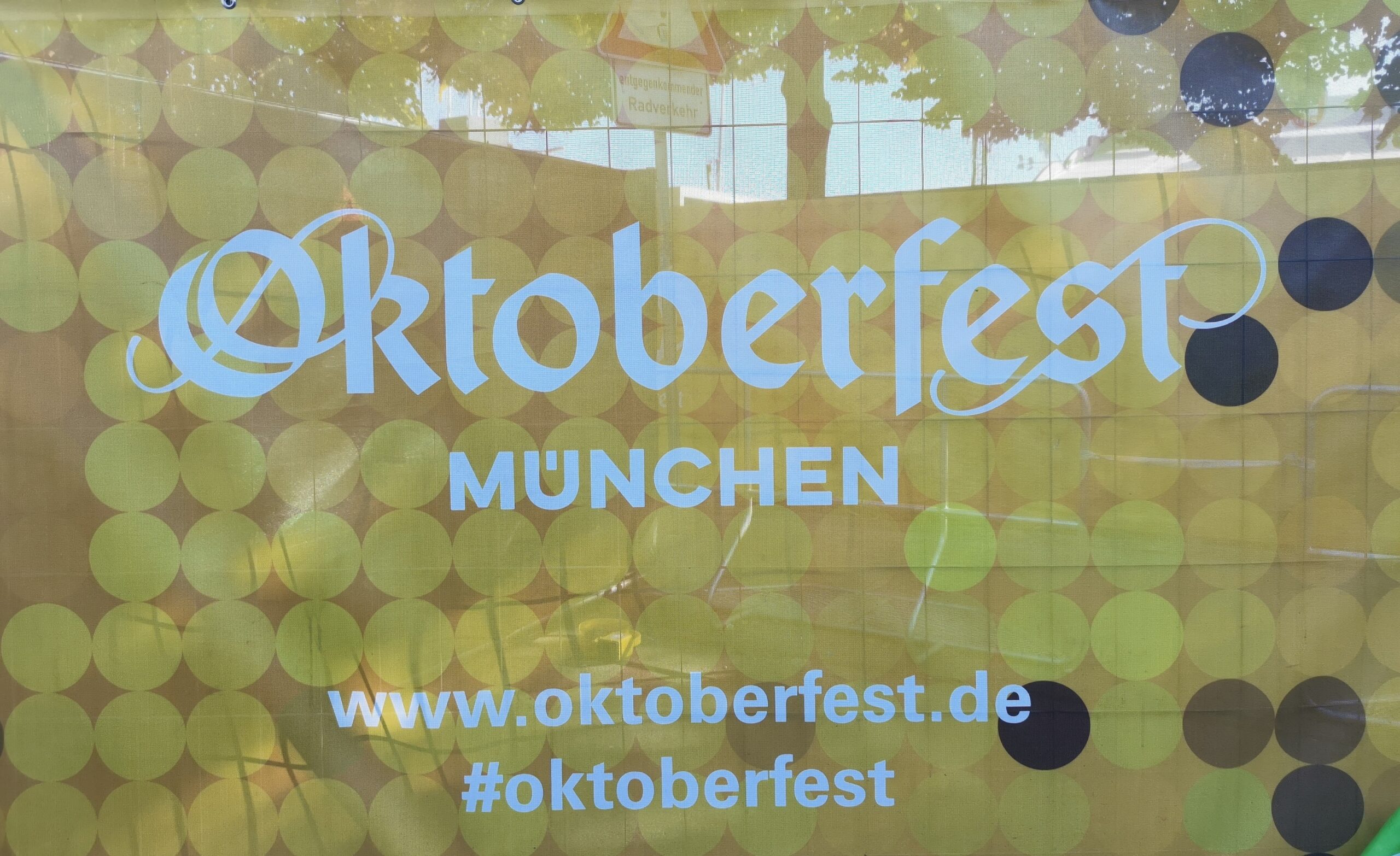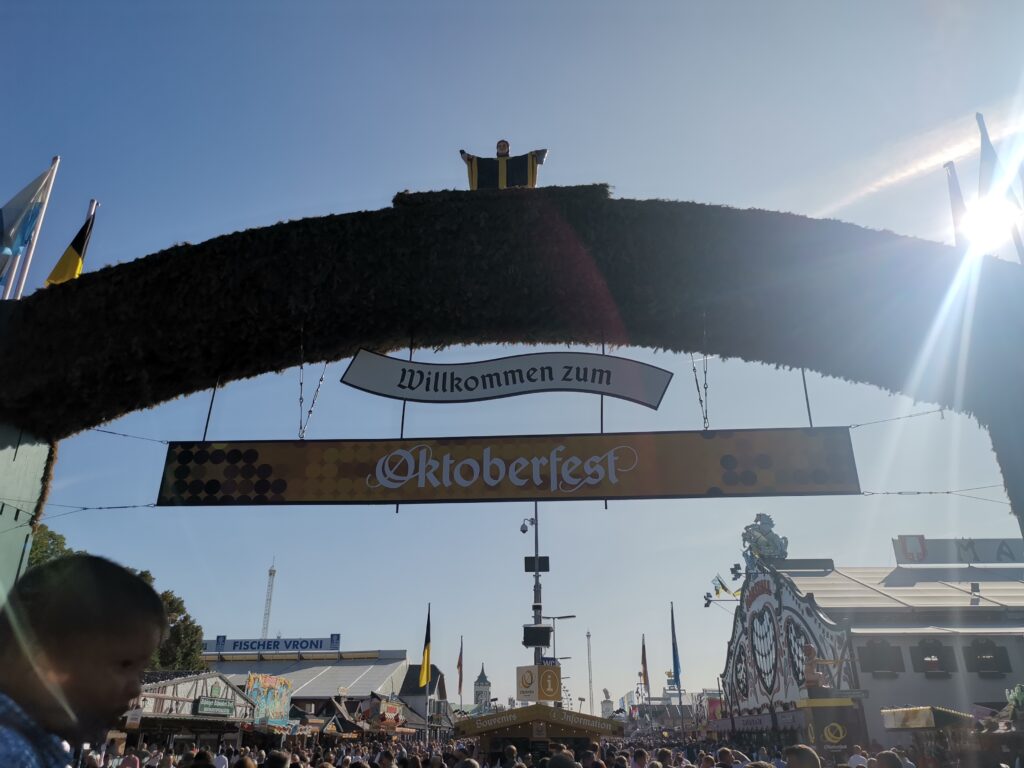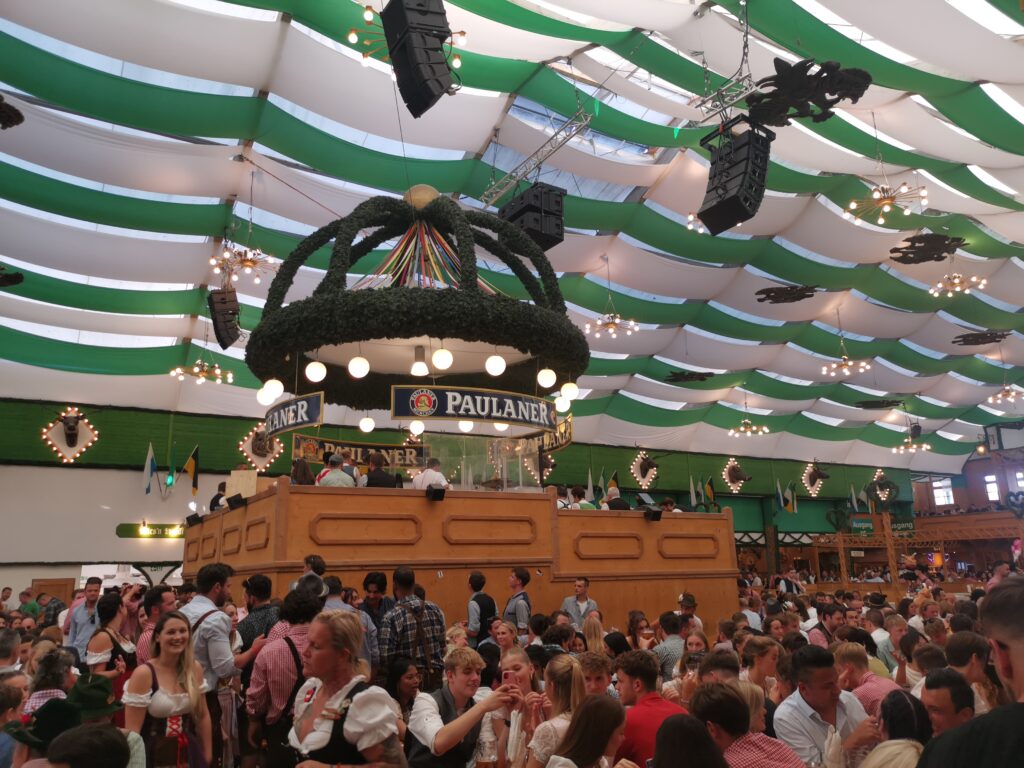The Bavarian state capital of Munich, in southern Germany, successfully combines a lively modern culture with a rich historical past. This beautiful city is well known for its exquisite architecture, top-notch museums, verdant parks, and a thriving food scene.
Historic Sites: Munich is littered with well-known historical sites, including Nymphenburg Palace, an ornate Baroque masterpiece, and Marienplatz, where the Glockenspiel delighted onlookers. While the Frauenkirche’s soaring spires dominate the city’s skyline, the Munich Residenz displays imperial opulence.
Museums and Galleries: The city has a fantastic art and cultural scene. Take a tour of The Pinakothek museums, explore the worlds of science and technology at the Deutsches Museum, or be mesmerised by cutting-edge vehicles at the BMW Welt.
Munich provides a diverse range of cultural experiences. Take in the mellow sounds of the Munich Philharmonic Orchestra by attending performances at the Bavarian State Theatre or the Munich Opera House. Participate in cultural events like the Tollwood Festival and the Munich Film Festival while learning about traditional Bavarian music.
Parks and Green Spaces: Unwind in the English Garden, one of the biggest urban parks in the world, or go to Olympiapark, the site of the Olympics in 1972. The Botanical Garden is a paradise for plant enthusiasts, while Nymphenburg Park and Westpark provide peaceful retreats.
Enjoy classic Bavarian cuisine; eat in inviting beer gardens, and experience flavors from throughout the world. Do not miss the vibrant street food markets or the busy Viktualienmarkt.
Munich is a captivating location for tourists looking for a varied and unforgettable experience due to its distinctive fusion of history, culture, natural beauty, and food.
In this article, we will give you the best things to do and see in Munich.
Visit Marienplatz and Glockenspiel
A trip to Munich’s Marienplatz and Glockenspiel is like entering the centre of the city’s thriving history and culture. Since the Middle Ages, Munich’s Marienplatz, often known as “Mary’s Square,” has served as the city’s primary intersection.
Marienplatz: elaborately crafted old buildings that house cafes, shops, and restaurants encircle this lively area. The New Town Hall (Neues Rathaus), a striking neo-Gothic building with its recognizable Glockenspiel, serves as the focal point.
The New Town Hall’s tower is home to the glockenspiel, which performs three times a day at 11 a.m., 12 p.m., and 5 p.m. (with an additional performance at 9 p.m. in the summer). The “Coopers’ Dance” and the “Riding of the Landsknechts” are two historical tales that are acted out by 32 life-size actors and 43 bells that make up the glockenspiel. It’s a mesmerizing show that draws large throngs of onlookers.
Visitor advice: The Town Hall’s observation deck offers stunning views of Marienplatz and the Glockenspiel. Explore the square’s beautiful shops and restaurants as well; it’s a great place for people-watching and enjoying Bavarian fare.
In addition to being works of art, Marienplatz and the Glockenspiel are also bustling gathering spots that provide a window into Munich’s colorful past and present. Anyone visiting the city should make time to go there.
Visit the Nymphenburg Palace
Visiting Munich’s Nymphenburg Palace is like taking a time machine to the luxurious realm of Bavarian aristocracy. This majestic palace, surrounded by verdant gardens and tranquil water features, is a reminder of Bavaria’s former glory.
Royal Residence: The Wittelsbach dynasty, who ruled over Bavaria, originally had Nymphenburg Palace constructed as a summer home. Its development started in the late 17th century and developed over time into a magnificent Baroque palace complex.
Architectural Masterpiece: The palace’s elaborate façade, expansive halls, and lavish interiors make it a masterpiece of Baroque architecture. Visitors can tour a variety of wings, each with a distinctive design, including the magnificent Gallery of Beauties, which King Ludwig I commissioned.
Wide-ranging gardens and parklands surround the palace, making them ideal for leisurely strolls. The bigger park offers a more natural setting with ponds and pavilions, while the Baroque garden has symmetrical designs, fountains, and statues.
Exhibitions at Museums: The Nymphenburg Palace now has a number of museums, including the Porcelain Museum and the Marstallmuseum, which feature beautiful porcelain collections and the royal carriages, respectively.
Visitor advice: Give yourself plenty of time to visit the castle and its gardens. To learn more about the history of the castle and the lives of Bavarian royalty, guided tours are offered.
Nymphenburg Palace is a must-see sight in Munich since it is not only a historical gem but also a lovely oasis of culture and environment. It provides a window into the opulent way of life of Bavarian nobility and a tranquil retreat from the busy city.
Festivals in Munich
Munich, the energetic capital of Bavaria, is well known for having a thriving and diversified festival scene all year round. The city’s rich cultural background, love of music, and, of course, its passion for beer are all on display at these events. The following are a few of Munich’s most prominent festivals:
- Oktoberfest: There is no need to introduce this famous beer festival. Oktoberfest, which takes place every year from the last weekend in September to the first weekend in October, draws millions of tourists from all over the world. At the Theresienwiese fairgrounds, guests may enjoy traditional Bavarian beer, cuisine, music, and the festive atmosphere.
- Munich Film Festival: This event, which takes place in late June and features a wide range of German and international films, from indie productions to blockbusters, is a treat for cinephiles.
- The Tollwood Winter and Summer Festival: is a biannual cultural extravaganza that features live theatre productions, art exhibits, concerts, and a variety of gourmet events. While the winter festival includes a wonderful Christmas market, the summer event is held at Olympiapark.
- Munich Opera event: This event honors classical music and opera, and it takes place in late June and early July. The Munich Opera Festival presents performances at famous locations including the National Theatre and draws well-known performers.
- Starkbierfest (Strong Beer Festival): This lesser-known but adored beer festival is held in the spring in Munich. It’s an opportunity to sample strong Bavarian beers like “Starkbier” or “Doppelbock” and take in traditional music and cuisine.
These events highlight Munich’s vibrant culture, friendly vibe, and ability to combine traditional and modern celebrations, making it an alluring destination for festival-goers.
If you would like to know the Best Ultimate Guide to Oktoberfest click here go to our post where you will receive the best information and some of our recommendations.
Nightlife in Munich
Munich’s nightlife is an exciting blend of history, global appeal, and a vivacious modern energy. The city has something for everyone, from classic beer gardens to cutting-edge clubs and all in between.
Beer Gardens: Munich is known for its renowned beer and its beer gardens. A genuine Bavarian experience may be had at establishments like the Hofbräuhaus and the Augustiner-Keller, which have substantial beers, traditional music, and communal tables beneath chestnut trees.
Nightclubs: The city’s nightlife offers something for every taste. Famous DJs and electronic music can be found at locations like P1 and Harry Klein, while alternative atmospheres and live performances can be found at Milchbar and Bullitt.
Munich has a lively pub scene, with bars and pubs. You can visit quaint, old-fashioned pubs like those in the Glockenbachviertel or go to more up-to-date, fashionable cocktail establishments for expertly made concoctions.
Cultural experiences: Attend opera and theatre performances at the National Theatre or Gärtnerplatz Theatre, or listen to classical music at locations like the Munich Philharmonic.
Late-Night Eateries: Munich is home to a variety of kebab stalls, sausage stands and cosy eateries serving hearty Bavarian food.
Festivals & Events: Munich is home to a number of cultural festivals and events, including the Tollwood Festival and the Munich Film Festival, which can go late into the night.
After the sun sets over this captivating Bavarian city, there is something for everyone to enjoy in Munich’s nightlife, which is an eclectic mix of old-world beauty and modern excitement.
Visit the Munich Residenz
The former royal palace and architectural wonder known as the Munich Residenz invites guests into a realm of regal splendor and historical significance. This magnificent edifice, located in the centre of Munich, served as the Bavarian monarchs’ royal residence for centuries.
The Munich Residenz exhibits a variety of architectural influences, from Renaissance to Baroque, making a tour through it a voyage through time and fashion. The opulent Antiquarium, the Residenz Museum with its rare art collections, and the Cuvilliés Theatre, a jewel of Rococo architecture, are among the attractions.
The Court Garden (Hofgarten) and other grand gardens of the Residenz offer a tranquil counterpoint to the luxury inside. You may learn more about the lives of the Bavarian kings and the art that characterized their age as you explore the Residenz.
The Munich Residenz offers visitors the chance to not only immerse themselves in history but also to appreciate the architectural skill and creative legacy that have influenced Munich’s cultural identity.
Visiting the Frauenkirche (Cathedral of Our Dear Lady)
One of Munich’s most recognizable structures and a representation of the city is the Frauenkirche, also known as the Cathedral of Our Dear Lady. Its two onion-domed towers, which form a distinctive silhouette that can be seen from a distance, dominate the skyline.
The Frauenkirche is a 15th-century architectural marvel that was constructed in the late Gothic style. The cathedral’s interior is similarly remarkable, with detailed stone carvings, stunning stained glass windows, and a calm environment that encourages reflection.
The tale surrounding the Frauenkirche is among its most intriguing features. Local legend holds that the architect entered into a deal with the devil to create the cathedral without windows. The astute architect, nevertheless, duped the devil and the cathedral now boasts the appearance of having no visible support columns.
The Frauenkirche is a must-see destination for people seeking both architectural beauty and historical intrigue in the center of the city since visitors can ascend to the top of one of its towers for panoramic views of Munich.
Visit the Viktualienmarkt
Anyone interested in Bavarian food, fresh products, and a bustling market ambiance should visit the Viktualienmarkt in Munich. This historic open-air market, which is in the centre of the city, has been a thriving centre of cuisine and culture for more than two centuries and a great place for those looking for flowers.
A fascinating selection of booths and sellers selling a wide variety of things can be found at the Virtualienmarkt. Fresh produce, artisanal cheeses, flavorful spices, and a wide variety of regional delicacies, such as pretzels and sausages from Bavaria, may all be found here.
Along with delicious food options, the market has attractive beer gardens where you can enjoy a cold Bavarian beer in a buzzing atmosphere. It’s the ideal place to unwind, observe people, and take in the friendly ambiance that Munich is famous for.
The Viktualienmarkt is a must-visit for foodies and anybody looking for a taste of real Bavarian culture in the center of the city. It embodies Munich’s culinary heritage.
Visit Odeonsplatz
A trip to Munich’s Odeonsplatz is like entering a real-life history book. This exquisite area is home to magnificent architectural and historical attractions and is steeped in Bavarian history.
The Theatinerkirche, a baroque-style church distinguished by its eye-catching yellow façade and pleasing proportions, is located in the center of Odeonsplatz. In the midst of the city’s bustle, it is a tranquil refuge. The Feldherrnhalle, a large loggia nearby, honours Bavaria’s military past.
The Wittelsbacher Palais and the Bavarian State Chancellery, which currently house a number of government departments, are further buildings with historical significance on the square. Other significant historical occurrences connected to Odeonsplatz include Adolf Hitler’s Beer Hall Putsch of 1923.
Odeonsplatz, which is surrounded by lovely gardens, provides a tranquil respite from the bustling metropolis. It’s the ideal location for a leisurely stroll, architectural adoration, and historical contemplation of Munich. Odeonsplatz is a must-see location whether you’re interested in history, architecture, or simply want to find a quiet place in the middle of Munich.
Visit Siegestor (Victory Gate)
A trip through history and an investigation of architectural meaning can be had by visiting Munich’s Siegestor, also known as the Victory Gate. This neoclassical triumphal arch, which is reminiscent of the Roman aqueducts, serves as a striking reminder of Bavaria’s past and her aspirations for the future.
The Siegestor, which was constructed in the 19th century, honors Bavaria’s involvement in the Napoleonic Wars and its eventual freedom. Bavaria is depicted on the gate’s central bronze figure, which is pulled by two figurative sculptures.
The Siegestor, which is situated at the end of Ludwigstrasse to the north, provides a grand entrance to the city’s historic district and the Ludwig-Maximilians-University. Due to its prominent location, it is a well-known landmark among both tourists and residents.
Beyond just serving as a reminder of the past, the Siegestor stands for Munich’s tenacity and steadfast character. Visitors can contemplate the occasions it honors while admiring its majesty and minute details. It serves as a beautiful backdrop for photography and a somber reminder of the city’s past.
Go Visit Dachau Concentration Camp
You seem to be referring to “Dachau,” which is the name of an important historical location. The main reason people associate Dachau with the Nazi concentration camp from World War II is the Dachau Concentration Camp.
One of the initial concentration camps founded by the Nazis in 1933, Dachau Concentration Camp situated in the German town of Dachau, a short distance north of Munich. It became a representation of the atrocities of the Holocaust and a model for later concentration camps. The camp held Jews, political prisoners, and members of other groups the Nazis had targeted. The conditions in Dachau were appalling, with numerous detainees succumbing to maltreatment, hard labour, and medical experiments.
The Dachau Concentration Camp is now a museum and memorial, acting as a somber reminder of the crimes committed during the Holocaust. Explore the grounds, take in the exhibitions, and pay their respects to the people who lost their lives at this tragic time in history. Dachau is proof of how crucial it is to keep in mind the past and draw lessons from it in order to make sure tragedies like this are never committed again.
Go Watch Bayern Munich Play Football
In the world of football, Bayern Munich—often just called Bayern—is a club with a legendary past and an unparalleled tradition. This 1900-founded Bavarian team has grown into one of the biggest teams in the world of football. A closer look at Bayern Munich is given below:
Domestic Dominance: With multiple Bundesliga championships and DFB-Pokal trophies under their belt, Bayern Munich is unquestionably the dominant team in German football. The club’s winning legacy is ingrained in its very being.
Champions League Success: The team has won the UEFA Champions League several times, and it is well-known throughout Europe. Their incredible performances in the competition have solidified their place as one of the biggest teams in world sport.
Iconic Players: Football superstars such as Franz Beckenbauer, Gerd Müller, Oliver Kahn, and current phenomenon Robert Lewandowski have graced Bayern Munich. The history of the club will never be the same because of these guys.
Allianz Arena: Known for its illuminated façade, the spectacular Allianz Arena serves as the club’s home field. Housed within this architectural wonder are the ardent Bayern supporters.
Worldwide Fanbase: One of the biggest and most devoted fan bases in the world is Bayern Munich’s. Because of their international backing, Bayern is a genuinely global club.
Dedicated to Excellence: The club embodies the concept of “Mia san mia” (We are who we are) via its dedication to youth development, social responsibility, and community involvement.
Bayern Munich’s unwavering quest of greatness demonstrated by their enduring football heritage. Their success on the European football scene as well as at home inspires and enthralls supporters everywhere.
Visit the Alte Pinakothek
A treasure trove of European art, the Alte Pinakothek in Munich is home to one of the largest collections of Old Masters in the entire globe. European painting from the Middle Ages to the end of the Baroque era is on display at this museum, which was established by King Ludwig I of Bavaria in the early 19th century.
Visitors can view works by well-known artists including Albrecht Dürer, Rembrandt, Raphael, Leonardo da Vinci, and Hieronymus Bosch inside the neoclassical structure. The collection includes religious artwork, portraits, landscapes, and historical themes, among other genres.
Art fans can immerse themselves in the eternal beauty of these outstanding works of art thanks to the museum’s interior design, which aims to create a calm and reflective atmosphere.
The Alte Pinakothek offers a deep appreciation of the skill and imagination of some of the greatest artists in history, taking visitors on a trip through the development of European art. For those who enjoy the arts and culture and are in Munich, it is a must-see.
13. Hop on Hop off Bus Tours in Munich
Hop-on, hop-off bus tours provide an easy way to discover Munich, the quaint capital of Bavaria, which has a wealth of historical and cultural attractions. The following explains why tourists favour these tours:
Effortless Touring: Hop-on, hop-off buses offer a convenient means of visiting Munich’s main sights. You may move around the city with ease if you have well-planned itineraries and strategically positioned stops.
Commentary that is Educational: These excursions frequently include audio guides who speak multiple languages and who will enlighten you while you ride about Munich’s history, culture, and famous sites.
Flexibility: You can get off at any stop and take your time exploring the region thanks to the “hop-on, hop-off” option. Before continuing the journey, you can stop at famous locations including Marienplatz, Nymphenburg Palace, and the BMW Museum.
Extensive Coverage: Munich’s hop-on, hop-off buses typically stop at a number of sites, such as parks, museums, historic areas, and more, so you won’t miss any of the city’s top attractions.
Convenient Mode of Transportation: If you’re travelling for the first time, this is a really practical way to get around. Important locations are simple to reach without having to bother about directions or public transit schedules.
Hop-on, hop-off bus tours in Munich are a fun and educational way to discover this hidden jewel of a city. They are a great option for both visitors and those looking for a thorough introduction to the city’s historical and cultural attractions.
14. English Garden (Englischer Garten)
The English Garden, also known as the Englischer Garten, is a sizable urban park in Munich, Germany, that is well-known for its scenic settings, recreational options, and natural beauty. With a total area of nearly 900 acres, it is among the biggest metropolitan parks in the world.
The park’s late 18th-century design includes meandering walkways, tranquil lakes, and lush vegetation. One of its distinctive features is the Eisbach, a man-made river where you can see surfers catch waves in the middle of the city.
The English Garden provides the ideal respite from the metropolitan commotion. You can take leisurely bike rides along its picturesque pathways or have a picnic by the tranquil Kleinhesseloher Lake. Traditional beer gardens, including the well-known Chinesischer Turm (Chinese Tower), can also be found in the park where you may enjoy regional ales and Bavarian fare.
The English Garden is a must-visit location for tourists travelling to Munich since it offers an exquisite backdrop for everything, whether you are seeking outdoor experiences, quiet moments, or a taste of Bavarian culture.
























